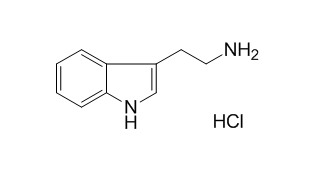Tryptamine hydrochlorideCAS# 343-94-2 |

Quality Control & MSDS
3D structure
Package In Stock
Number of papers citing our products

| Cas No. | 343-94-2 | SDF | Download SDF |
| PubChem ID | 67652 | Appearance | Powder |
| Formula | C10H13ClN2 | M.Wt | 196.7 |
| Type of Compound | Alkaloids | Storage | Desiccate at -20°C |
| Solubility | Soluble in Chloroform,Dichloromethane,Ethyl Acetate,DMSO,Acetone,etc. | ||
| Chemical Name | 2-(1H-indol-3-yl)ethanamine;hydrochloride | ||
| SMILES | C1=CC=C2C(=C1)C(=CN2)CCN.Cl | ||
| Standard InChIKey | KDFBGNBTTMPNIG-UHFFFAOYSA-N | ||
| Standard InChI | InChI=1S/C10H12N2.ClH/c11-6-5-8-7-12-10-4-2-1-3-9(8)10;/h1-4,7,12H,5-6,11H2;1H | ||
| General tips | For obtaining a higher solubility , please warm the tube at 37 ℃ and shake it in the ultrasonic bath for a while.Stock solution can be stored below -20℃ for several months. We recommend that you prepare and use the solution on the same day. However, if the test schedule requires, the stock solutions can be prepared in advance, and the stock solution must be sealed and stored below -20℃. In general, the stock solution can be kept for several months. Before use, we recommend that you leave the vial at room temperature for at least an hour before opening it. |
||
| About Packaging | 1. The packaging of the product may be reversed during transportation, cause the high purity compounds to adhere to the neck or cap of the vial.Take the vail out of its packaging and shake gently until the compounds fall to the bottom of the vial. 2. For liquid products, please centrifuge at 500xg to gather the liquid to the bottom of the vial. 3. Try to avoid loss or contamination during the experiment. |
||
| Shipping Condition | Packaging according to customer requirements(5mg, 10mg, 20mg and more). Ship via FedEx, DHL, UPS, EMS or other couriers with RT, or blue ice upon request. | ||
| Description | Tryptamine hydrochloride has antioxidative effects. | |||||

Tryptamine hydrochloride Dilution Calculator

Tryptamine hydrochloride Molarity Calculator
| 1 mg | 5 mg | 10 mg | 20 mg | 25 mg | |
| 1 mM | 5.0839 mL | 25.4194 mL | 50.8388 mL | 101.6777 mL | 127.0971 mL |
| 5 mM | 1.0168 mL | 5.0839 mL | 10.1678 mL | 20.3355 mL | 25.4194 mL |
| 10 mM | 0.5084 mL | 2.5419 mL | 5.0839 mL | 10.1678 mL | 12.7097 mL |
| 50 mM | 0.1017 mL | 0.5084 mL | 1.0168 mL | 2.0336 mL | 2.5419 mL |
| 100 mM | 0.0508 mL | 0.2542 mL | 0.5084 mL | 1.0168 mL | 1.271 mL |
| * Note: If you are in the process of experiment, it's necessary to make the dilution ratios of the samples. The dilution data above is only for reference. Normally, it's can get a better solubility within lower of Concentrations. | |||||

Calcutta University

University of Minnesota

University of Maryland School of Medicine

University of Illinois at Chicago

The Ohio State University

University of Zurich

Harvard University

Colorado State University

Auburn University

Yale University

Worcester Polytechnic Institute

Washington State University

Stanford University

University of Leipzig

Universidade da Beira Interior

The Institute of Cancer Research

Heidelberg University

University of Amsterdam

University of Auckland

TsingHua University

The University of Michigan

Miami University

DRURY University

Jilin University

Fudan University

Wuhan University

Sun Yat-sen University

Universite de Paris

Deemed University

Auckland University

The University of Tokyo

Korea University
- Cinnamtannin A2
Catalog No.:BCN9889
CAS No.:86631-38-1
- Tribulosin
Catalog No.:BCN9888
CAS No.:79974-46-2
- 4-Oxadocosane-1,2-diol
Catalog No.:BCN9887
CAS No.:544-62-7
- 15-Deoxypulic acid
Catalog No.:BCN9886
CAS No.:95523-05-0
- 6-Methoxyflavanone
Catalog No.:BCN9885
CAS No.:3034-04-6
- (1S,2S,5S)-(-)-Myrtanol
Catalog No.:BCN9884
CAS No.:53369-17-8
- 2-(2-Hydroxybenzal)acetophenone
Catalog No.:BCN9883
CAS No.:644-78-0
- gamma-Decalactone
Catalog No.:BCN9882
CAS No.:706-14-9
- 5,7-Dihydroxy 3,3',4',5',6,8-hexamethoxyflavone
Catalog No.:BCN9881
CAS No.:96887-18-2
- Cymarin
Catalog No.:BCN9880
CAS No.:508-77-0
- Dihydroquinine
Catalog No.:BCN9879
CAS No.:522-66-7
- Tricaprin
Catalog No.:BCN9878
CAS No.:621-71-6
- Caffeoyl alcohol
Catalog No.:BCN9891
CAS No.:3598-26-3
- 5-Geranoxy-7-methoxycoumarin
Catalog No.:BCN9892
CAS No.:7380-39-4
- (-)-Linalool
Catalog No.:BCN9893
CAS No.:126-91-0
- Methyl anthranilate
Catalog No.:BCN9894
CAS No.:134-20-3
- 3-Octanone
Catalog No.:BCN9895
CAS No.:106-68-3
- Decanoic acid
Catalog No.:BCN9896
CAS No.:334-48-5
- 3',4'-Dimethoxyflavone
Catalog No.:BCN9897
CAS No.:4143-62-8
- Dihydroisoferulic acid
Catalog No.:BCN9898
CAS No.:1135-15-5
- cis-Jasmone
Catalog No.:BCN9899
CAS No.:488-10-8
- Methyl benzoate
Catalog No.:BCN9900
CAS No.:93-58-3
- Bufotenine
Catalog No.:BCN9901
CAS No.:487-93-4
- 3-Methyl ellagic acid
Catalog No.:BCN9902
CAS No.:51768-38-8
Four Novel Synthetic Tryptamine Analogs Induce Head-Twitch Responses and Increase 5-HTR2a in the Prefrontal Cortex in Mice.[Pubmed:31230432]
Biomol Ther (Seoul). 2019 Jun 24:83-91.
Tryptamines are monoamine alkaloids with hallucinogenic properties and are widely abused worldwide. To hasten the regulations of novel substances and predict their abuse potential, we designed and synthesized four novel synthetic tryptamine analogs: Pyrrolidino Tryptamine hydrochloride (PYT HCl), Piperidino Tryptamine hydrochloride (PIT HCl), N,N-dibutyl Tryptamine hydrochloride (DBT HCl), and 2-Methyl Tryptamine hydrochloride (2-MT HCl). Then, we evaluated their rewarding and reinforcing effects using the conditioned place preference (CPP) and self-administration (SA) paradigms. We conducted an open field test (OFT) to determine the effects of the novel compounds on locomotor activity. A head-twitch response (HTR) was also performed to characterize their hallucinogenic properties. Lastly, we examined the effects of the compounds on 5-HTR1a and 5-HTR2a in the prefrontal cortex using a quantitative real-time polymerase chain reaction (qRT-PCR) assay. None of the compounds induced CPP in mice or initiated SA in rats. PYT HCl and PIT HCl reduced the locomotor activity and elevated the 5-HTR1a mRNA levels in mice. Acute and repeated treatment with the novel tryptamines elicited HTR in mice. Furthermore, a drug challenge involving a 7-day abstinence from drug use produced higher HTR than acute and repeated treatments. Both the acute treatment and drug challenge increased the 5-HTR2a mRNA levels. Ketanserin blocked the induced HTR. Taken together, the findings suggest that PYT HCl, PIT HCl, DBT HCl, and 2-MT HCl produce hallucinogenic effects via 5-HTR2a stimulation, but may have low abuse potential.


